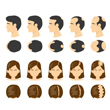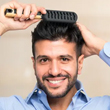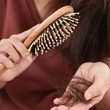What You Need to Know About Using Baking Soda on Your Hair?
People are using baking soda to replace shampoos, but is this a foolproof method? No, there are many unpleasant side effects, and you can end up damaging your hair. The new fad is in line with the "no-poo" (as in no shampoo) concept that is gaining popularity today.(1)

The method involves dissolving baking soda in water and applying it to the hair. It is believed to get rid of excess oil and build-up, restore it, and make it shiny. But individuals have reported severe hair damage as a result of the baking soda for hair method.
Does Baking Soda Make Hair Light?
You can get a lighter hair shade with a few washes with baking soda. For more effective results, you can combine it with other chemicals like selenium sulphide and hydrogen peroxide.
To make non-dyed hair lighter, you can apply a paste of baking soda and hydrogen peroxide in a ratio of 2:1.5 to your hair. Rinse after 30 minutes to an hour. To use baking soda on its own, add water to baking soda to make a thin paste and apply it to your hair. Rinse it after 15 to 20 minutes.

You can also get good results by using baking soda for hair in combination with anti-dandruff shampoo. Make a paste by mixing both ingredients in a 1:1 ratio and applying it to your hair. Rinse your hair thoroughly after five to ten minutes. (2)
Procedure for Applying Baking Soda to Hair
Have you ever noticed the money you spend on hair products, especially the so-called natural products? You can end up spending a considerable amount of money on natural hair products, but it doesn't always have to be that way.
To avoid store-bought products, you can make home remedies for your hair. A popular treatment is a baking soda for hair that you use as a substitute for shampoos.
Mix a tablespoon of baking soda with ¼ litre of warm water. Mix thoroughly until the baking soda dissolves. Pour the solution on your hair and rinse thoroughly after a few minutes.
You can make a natural conditioner by adding a couple of tablespoons of apple cider vinegar and lemon juice to ¼ litre of warm water. It can cancel the negative effect of baking soda.(3)
Possible Hazards of applying Baking Soda to your Hair
There is no conclusive evidence that baking soda benefits your hair. In fact, it may cause damage. The natural pH level of the scalp is about 5.5, and that of a hair shaft is around 3.67. But with a pH level of 9, baking soda is quite an alkaline substance, making it highly abrasive.

Using baking soda for hair can cause cuticle damage, increase broken ends, and even make your hair frizzy. The pH level of the human skin is 5.5. Continued exposure to baking soda with a pH level of 9 can reduce the fat content of your skin and cause irritation.
We can conclude that baking soda can be beneficial initially. The high pH level of baking soda is effective for removing build-up and may dry out the scalp. But in the case of long-term use, it will eliminate the natural oils of your hair, thereby causing damage, and could even irritate your skin.(4)
Alternatives to Apply to Hair Instead of Baking Soda
All evidence seems to point out that baking soda can cause more damage than good with long-term use. Healthy hair relies on several factors within your control
You can prevent hair damage by using chemicals and blow dryers sparingly. Also, avoid undue exposure of your hair to the elements. Consider your hair type (straight, curly, strong, thick, or thin) and treat it appropriately. You also need to consider your scalp type.

Here are a few pointers for proper hair care, especially if you start using natural products or use natural home remedies:
Clarifying Shampoo
Use a clarifying shampoo that removes product build-up and oil. It should contain surfactants like sodium lauryl sulphate. But avoid excessive use of such shampoos if you have a dry scalp.
Coconut Oil
Coconut oil prevents hair breakage by penetrating the hair shaft. You can use it as a preconditioner and post-conditioner, but avoid excessive use, or your hair may develop an oily appearance.
A Good-Quality Hair Conditioner
Use a good conditioner for smooth, soft, and silky hair. Conditioners that contain keratin and silicones and oils such as jojoba and argan are the best choice.(5)
Conclusion
If you want to avoid shampoos, using baking soda for hair is not a very good idea. It can damage your hair and even irritate your skin. There are many natural substitutes like Aloe Vera, shikakai, and coconut oil. If you must use baking soda, then do so sparingly to avoid damage to your hair and use other natural substitutes instead. (6)
Possible Benefits of Applying Baking Soda to Hair: FAQs
We use baking soda for a variety of purposes, particularly in household cleaning. It is a somewhat effective cleaning agent. Many people claim that you can use baking soda as an adequate substitute for shampoo. Let us take a look at the possible benefits of using baking soda for hair.
Q. 1: Can baking soda clean your scalp?
Ans: Baking soda is an effective agent to cut grease. We use it for cleaning stoves and window grills. Hair products leave messy residues that baking soda can get rid of. But you need to use it in moderation.
Q. 2: Is baking soda safe?
Ans: Baking soda is a potent cleaning agent which you should use sparingly on your body. It can be particularly harsh on hair. Excessive baking soda use can cause severe damage to your hair, like making it brittle, and the strands can break. It can also cause skin irritation.
Q. 3: Can you treat alopecia (baldness) by cleaning your scalp with baking soda?
Ans: Using baking soda for hair will not do much to treat alopecia if you have it. Alopecia occurs for many reasons, like medication side effects, hormonal imbalance, stress, and genes. There is no guaranteed cure for alopecia, but temporary alopecia (like during or after pregnancy) may subside on its own. (7)
Myth Busters HairFall

Androgenetic Alopecia - Everything You Need To Know
Have you been experiencing excessive hair fall over a prolonged period of time? It could be an early sign of androgenetic alopecia. It is a hair loss disorder common in both genders and can lead to progressive thinning and even baldness in some patients if not caught and treated early.

How To Make Hair Grow Faster For Men
A head full of healthy hair is a matter of confidence. Hair has its own mechanism of growing and shedding, and it is when this mechanism is thrown off that growth is hindered. Especially in the case of males, hair growth faces a lot of hiccups that can easily be managed.

Female Pattern Baldness - Causes & Treatments
Have you suddenly noticed an increase in the number of hair strands on your pillow in the morning? Or is your ponytail getting thinner by day? Well, you might be suffering from female pattern baldness. While that does sound scary, identifying it early on is key to treating this condition effectively. So keep reading to know what this is, how you can identify it, and most importantly, what treatments you can avail of to get your beautiful lustrous hair back.

What Are The Reasons For Hairfall?
Almost everyone experiences some amount of hair thinning over the years. Shedding around 50 to 100 single strands of hair per day is considered normal. However, losing more than 150 strands a day, experiencing sudden thinning, or developing circular bald patches on your scalp are reasons for concern. Hair loss occurs when new hair doesn’t grow fast enough to replace the amount of hair you lose daily. Hair can fall due to various reasons, with hereditary hair loss and poor nutrition being the most common hair fall reasons.

Expert Approved Tips For Hair Growth
What can be more debilitating than seeing hundreds of hair strands shedding from your scalp every time you brush your hair? Also, excessive molting occurs during seasonal changes that can be very stressful for you. Although it’s okay to lose between 50-100 strands every day, according to the American Academy of Dermatology, the problem occurs when you start shedding more than normal. But that doesn’t mean you have to feel helpless as there are ways to grow your hair back. Even if you are coping with baldness or alopecia, certain hair growth tips from dermatologists can come to your rescue. Read on to discover how these tips can be your savior when abnormal hair fall problems are in sight.
Trending Videos
+ 7 Sources
'LMRC - GGI-CO-A2-DMA-300001252-300001252-WM-L21-704'
© 2021 Dr. Reddy’s Laboratories Ltd. All rights reserved.